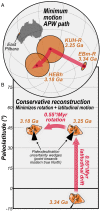Plate motion and a dipolar geomagnetic field at 3.25 Ga
- PMID: 36279430
- PMCID: PMC9636958
- DOI: 10.1073/pnas.2210258119
Plate motion and a dipolar geomagnetic field at 3.25 Ga
Abstract
The paleomagnetic record is an archive of Earth's geophysical history, informing reconstructions of ancient plate motions and probing the core via the geodynamo. We report a robust 3.25-billion-year-old (Ga) paleomagnetic pole from the East Pilbara Craton, Western Australia. Together with previous results from the East Pilbara between 3.34 and 3.18 Ga, this pole enables the oldest reconstruction of time-resolved lithospheric motions, documenting 160 My of both latitudinal drift and rotation at rates of at least 0.55°/My. Motions of this style, rate, and duration are difficult to reconcile with true polar wander or stagnant-lid geodynamics, arguing strongly for mobile-lid geodynamics by 3.25 Ga. Additionally, this pole includes the oldest documented geomagnetic reversal, reflecting a stably dipolar, core-generated Archean dynamo.
Keywords: Archean geodynamics; geodynamo; hydrothermal alteration; paleomagnetism; plate tectonics.
Conflict of interest statement
The authors declare no competing interest.
Figures






Comment in
-
Paleoarchean plate motion: Not so fast.Proc Natl Acad Sci U S A. 2023 Jan 3;120(1):e2218383120. doi: 10.1073/pnas.2218383120. Epub 2022 Dec 27. Proc Natl Acad Sci U S A. 2023. PMID: 36574694 Free PMC article. No abstract available.
-
Reply to Mitchell and Jing: True polar wander alone is insufficient to drive measured Paleoarchean lithospheric motions.Proc Natl Acad Sci U S A. 2023 Jan 3;120(1):e2219560120. doi: 10.1073/pnas.2219560120. Epub 2022 Dec 27. Proc Natl Acad Sci U S A. 2023. PMID: 36574704 Free PMC article. No abstract available.
Similar articles
-
Paleomagnetic evidence for Neoarchean plate mobilism.Nat Commun. 2024 Dec 30;15(1):10814. doi: 10.1038/s41467-024-55117-w. Nat Commun. 2024. PMID: 39737974 Free PMC article.
-
Paleomagnetic evidence for modern-like plate motion velocities at 3.2 Ga.Sci Adv. 2020 Apr 22;6(17):eaaz8670. doi: 10.1126/sciadv.aaz8670. eCollection 2020 Apr. Sci Adv. 2020. PMID: 32494654 Free PMC article.
-
PALEOMAGNETISM. A Hadean to Paleoarchean geodynamo recorded by single zircon crystals.Science. 2015 Jul 31;349(6247):521-4. doi: 10.1126/science.aaa9114. Science. 2015. PMID: 26228145
-
Two styles of plate tectonics in Earth's history.Sci Bull (Beijing). 2020 Feb 26;65(4):329-334. doi: 10.1016/j.scib.2018.12.029. Epub 2019 Dec 16. Sci Bull (Beijing). 2020. PMID: 36659098 Review.
-
On the genesis of the Earth's magnetism.Rep Prog Phys. 2013 Sep;76(9):096801. doi: 10.1088/0034-4885/76/9/096801. Epub 2013 Sep 4. Rep Prog Phys. 2013. PMID: 24004491 Review.
Cited by
-
Paleomagnetic evidence for Neoarchean plate mobilism.Nat Commun. 2024 Dec 30;15(1):10814. doi: 10.1038/s41467-024-55117-w. Nat Commun. 2024. PMID: 39737974 Free PMC article.
-
Reply to Mitchell and Jing: True polar wander alone is insufficient to drive measured Paleoarchean lithospheric motions.Proc Natl Acad Sci U S A. 2023 Jan 3;120(1):e2219560120. doi: 10.1073/pnas.2219560120. Epub 2022 Dec 27. Proc Natl Acad Sci U S A. 2023. PMID: 36574704 Free PMC article. No abstract available.
-
Strong link between Earth's oxygen level and geomagnetic dipole revealed since the last 540 million years.Sci Adv. 2025 Jun 13;11(24):eadu8826. doi: 10.1126/sciadv.adu8826. Epub 2025 Jun 13. Sci Adv. 2025. PMID: 40512863 Free PMC article.
-
Paleoarchean plate motion: Not so fast.Proc Natl Acad Sci U S A. 2023 Jan 3;120(1):e2218383120. doi: 10.1073/pnas.2218383120. Epub 2022 Dec 27. Proc Natl Acad Sci U S A. 2023. PMID: 36574694 Free PMC article. No abstract available.
-
Geology's biggest mystery: when did plate tectonics start to reshape Earth?Nature. 2024 Aug;632(8025):490-492. doi: 10.1038/d41586-024-02602-3. Nature. 2024. PMID: 39143339 No abstract available.
References
-
- Matthews K. J., et al. , Global plate boundary evolution and kinematics since the late Paleozoic. Global Planet. Change 146, 226–250 (2016).
-
- Wallace L. M., McCaffrey R., Beavan J., Ellis S., Rapid microplate rotations and backarc rifting at the transition between collision and subduction. Geology 33, 857–860 (2005).
-
- McElhinny M., Senanayake W., Paleomagnetic evidence for the existence of the geomagnetic field 3.5 Ga ago. J. Geophys. Res. Solid Earth 85, 3523–3528 (1980).
Publication types
MeSH terms
LinkOut - more resources
Full Text Sources

